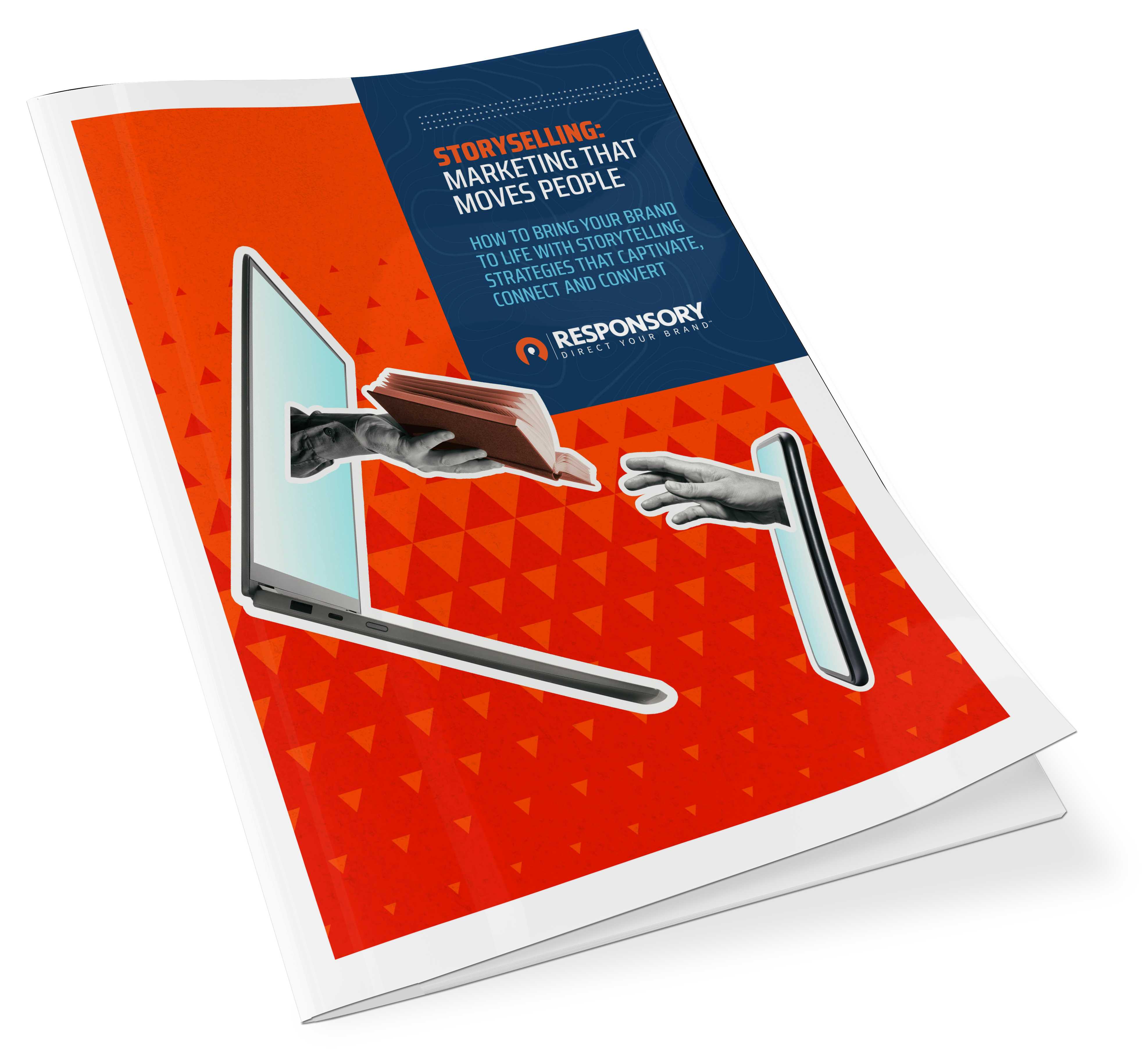How Pharmaceutical Brands Can Create Emotional Connections with HCPs & Patients Using Storytelling
Everyone loves a good story, but in pharma marketing, stories can do even more. Storyselling blends the art of storytelling with the science of influence — giving brands the power to resonate with HCPs and patients in lasting ways.
In This Blog
Free Download
In an industry rooted in research, data, compliance and clinical outcomes, it’s easy to forget the emotional side of healthcare. But for pharmaceutical marketers, it’s the human connection that sets memorable brands apart. That’s where medical storyselling comes in — the strategic use of storytelling to bridge the gap between complex science and the real people it benefits.
Whether you’re trying to engage healthcare providers (HCPs), build trust with patients, or differentiate your brand in a crowded space, storyselling isn’t just a creative exercise — it’s a proven marketing strategy that drives measurable results. Let’s explore how pharma brands can use storytelling to build stronger emotional connections, increase engagement and inspire action.
What is Medical Storyselling?
Medical storyselling is the art (and science) of using storytelling techniques to communicate the value of a healthcare brand in a way that resonates emotionally — while still delivering factual accuracy. It’s not about making up stories. It’s about bringing data to life by framing it in terms of human experience.
In pharma marketing, where complex science and high stakes can overwhelm and intimidate patients, storyselling serves as an important bridge. It helps demonstrate:
- Inspiring action through relatable stories of a patient’s treatment journey
- Turning clinical outcomes into real-world impact
- Presenting patient challenges into stories of hope, encouragement or even survival
This approach helps HCPs and patients truly resonate with your messaging, and most importantly, remember it. In fact, studies show stories engage more parts of the brain than reading raw data, making them more persuasive and memorable.
Why Storytelling Matters in Pharma Marketing
Pharma marketers have long faced a unique challenge: how to communicate complex, critical information in a way that captures patients’ attention, while building trust and ultimately inspiring action — all within a heavily regulated and controlled environment. Yikes.
Not to fear. Storyselling can help address this challenge by transforming technical, data-heavy messaging into content that’s relatable, transparent and memorable. Here’s why this is important:
- Enhances HCP Engagement: Healthcare providers are bombarded with a barrage of information every day. A compelling story can cut through some of this noise. By presenting treatment benefits through real patient testimonials, pharma brands can capture attention and build an emotional connection by appealing to the responsibility physicians have for their patients.
- Builds Patient Trust: For some patients, pharma brands can feel like a big, looming entity — something disconnected, that sees patients as just another number. Storyselling can help flip this perspective by focusing on shared experiences, allowing patients to see themselves in the journey. When people feel seen and heard, they’re more open to trusting your brand and taking action — whether talking to their doctor or trying a new prescription.
- Differentiates in a Crowded Market: When drugs offer similar treatments or indications, how pharma brands tell their story can be their biggest competitive advantage. Storyselling helps position your brand as more empathetic, relatable and connected — qualities that drive long-term loyalty and can turn patients into advocates.
Now that we’ve explored the importance of storyselling, and how crucial it is for pharma brands to establish that emotional connection, the big question remains: just how does all this translate into marketing to HCPs and patients?
Storytelling Strategies for Engaging HCPs
If you’ve ever waited, and waited, and waited in an exam room for your doctor’s appointment to begin, then you know that physicians and nurses are always pressed for time. By the time they’re done with your appointment, they are probably late to their next one and are simultaneously getting paged about something else. So how do you make your brand’s messaging heard in all this chaos? By being relevant and backing up your story with facts.
Data-Driven Narratives
HCPs rely on evidence (like clinical data and test results) — but numbers alone don’t always change their minds or spark action. Effective pharma storytelling for HCPs needs to weave together clinical data with real-world context, like using patient testimonials backed with figures from case studies to demonstrate effective treatment. Responsory has this down to a science (no pun intended). See how we leveraged real-time prescription data into a successful email campaign targeted to sleep medicine physicians.
The Hero’s Journey in Medicine
Want your messaging to really resonate? Put the HCP (or better yet, their patients) at the center of your story. Thinking back to high school English class, the “Hero’s Journey” story model can help craft messaging that positions your drug as the solution to a larger struggle such as finding relief while battling chronic conditions, known harsh side effects from a competitor’s drug, or for generic products: combatting high prices with branded medications. This structure taps into universal storytelling themes and helps HCPs see the human impact behind the narrative.
Personalization in Storytelling
One-size-fits-all messaging rarely hits home with HCPs. Their practices areas are diverse, nuanced, and courses of treatment can be as unique as the patients they prescribe for. Therefore, your messaging needs to be just as specialized and tailored. Personalization is key. Speak the doctor’s language and approach your messaging with intimate knowledge of their patients’ struggles, fears and challenges. This will help build that all-important bond of trust and bolster your brand’s authority in this treatment or practice area.
Storytelling Strategies for Engaging Patients
Patients don’t think in clinical trials and data points. They think in terms of finding relief, seeking hope and battling real-life challenges. Storyselling helps you meet them where they are — with empathy, clarity and credibility.
Patient-Centric Narratives
Humanizing your brand to speak to patients starts with highlighting real patient experiences. Testimonials and success stories, and when compliant, can:
- Build emotional trust
- Provide proof of treatment outcomes
- Help patients see themselves in others’ journeys, and know they are not alone
Real stories give your brand a face and voice patients can relate to, making the treatments and therapies feel less clinical and more accessible. Just be sure to work within regulatory guidelines and HIPAA compliance (don’t worry—we’ve got you covered there. Keep reading).
Simplifying Complex Medical Information
No doubt you’ve seen those drug commercials where they rattle off the side effects so fast, you can barely understand what they’re saying. Medical jargon can confuse, overwhelm and alienate patients. So, while you are required to include certain verbiage and content in your advertising executions, that doesn’t mean you can’t simplify it for everyone to understand. So, where’s the happy medium?
- Use metaphors and analogies: Comparing a drug or treatment to a well-oiled machine or hitting a magical “reset button” can help improve patient comprehension.
- Employ visual storytelling: Include infographics, animations and explainer videos to help break down new diagnoses, how a medication works in the body, or even complicated dosing instructions, into easily digestible formats.
The Role of Authenticity
Patients can be skittish with pharmaceutical marketing when it often feels like a tidal wave of information roaring towards them. Establishing yourself as a trustworthy, authoritative friend can help alleviate this fear. Studies show that 64% of consumers want brands to connect with them emotionally. So, how do you toss them that life preserver with your messaging?
- Avoid overpromising or exaggerated, miraculous outcomes. Patients can sense this is too good to be true and will suspect there’s a “catch.”
- Partner with patient advocacy groups or community voices for added credibility. This helps to validate patients, allowing them to see that you’re there in the trenches fighting the fight with them.
- Be open and transparent about risks, side effects and what patients can expect. Remember to use plain language and explain things like you’re talking to a real person. Because at the end of the day, you are.
Compliance and Ethical Considerations
We promised we’d have your back navigating the wild world of pharmaceutical marketing and regulatory compliance. We have a wealth of knowledge in this arena, if we do say so ourselves. Let’s dive in.
Regulatory Guidelines
It’s crucial to always make sure your messaging aligns with:
- FDA regulations: Avoid off-label claims or unfounded statements of treatment or cures. Also, don’t speak with sweeping generalizations. Use language such as, “this can help your patients do x,y,z…” or “you could experience relief in as little as…”
- HIPAA compliance: Any patient stories or testimonials must have their identity removed or be used with written consent from the patient.
- PhRMA Code: Follow ethical marketing principles when engaging with HCPs
Striking the right balance between an emotional tie and factual accuracy is where pharma marketers earn their stripes. The goal is always to inspire trust and demonstrate your authority, not open yourself up for liability.
Transparency and Disclosure
All case studies, testimonials and third-party endorsements should include:
- Clear disclosures about compensation or partnerships.
- Cited data sources for all medical or clinical claims.
- Legal or medical review processes to ensure compliance and consistency.
Transparency builds authority, trust and credibility — and helps safeguard your brand’s messaging from regulatory red flags.
How to Build a Pharma Storyselling Strategy
If you’re ready to start turning facts into feelings and data into emotional connections, here’s how to start.
Step 1: Define the Narrative Framework
First, ask yourself, how do we want our target audience to feel and what do we want them to do?
- Education – simplifying complex science with simple language and transparency.
- Inspiration – showing the impact of treatment.
- Reassurance – guiding patients through uncertainty by allowing them to see themselves in your narrative.
- Advocacy – empowering HCPs to make confident treatment choices backed by facts and addressing issues that keep them up at night.
Step 2: Choose the Right Format
Physicians will engage with various channels and platforms differently than patients. Tailor your storyselling format to mimic their behaviors. Make sure your messaging appears in the spaces and places where your audience is.
- Blogs and whitepapers can provide deep dives and exploration into complex concepts.
- Video testimonials or animations can be used for quick emotional connections.
- Paid social media campaigns can further help humanize your brand, boosting its approachability.
- Video or audio podcasts can deliver nuanced discussions in a convenient, on-the-go format.
- Webinars and policy briefs can educate and influence HCPs in content they are used to consuming.
Step 3: Test & Optimize
This is not the time to “set it and forget it.” Use data and feedback to refine and readjust your approach, keeping it fresh and relevant.
- A/B testing different headlines or formats
- Conduct surveys and interviews with HCPs and patients
- Track performance metrics on key channels and analytics and pivot your messaging accordingly
Remember: storyselling is a living strategy, not a static campaign.
Connect Through Stories, Foster Empathy and Build Trust
Pharmaceutical marketing isn’t just about what your product does or treats — it’s about who it impacts, how it feels and why it matters. Storyselling gives your brand the tools to connect emotionally with hearts and minds — while staying grounded in science, facts and compliance. With the right strategy, format and testing, your brand’s stories can drive measurable outcomes. If you’re ready to build powerful narratives and see how storytelling can elevate your next campaign, Responsory is here to help. Explore our full storyselling blog series to discover even more insights.
Give us a call, and let’s tell your story.

About the Author
In her role as Senior Account Manager, Kristin Dixon brings her expertise to overseeing every aspect of integrated marketing campaigns, from strategic planning to execution. With the mindset of an air traffic controller, she excels in fostering strong client relationships, ensuring each project stays true to its goals and objectives, while delivering impactful results. Outside of the world of marketing, you might find Kristin at the theatre. Not on the stage necessarily, but as a passionate spectator. A musical theater nerd, she ranks Hamilton, Wicked, and Rent among her top Broadway favorites. She’s also a huge Seinfeld fan and needs to quote lines from the show in just about every conversation (“not that there’s anything wrong with that”).

Free Download
Storyselling: Marketing That Moves People
Stop wasting time on content no one remembers. Start sharing stories your audience can’t forget.
Updated for 2025, download Storyselling: Marketing That Moves People to learn how to bring your brand to life with storytelling strategies that captivate, connect and convert.






